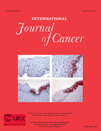Heritable and environmental components in cervical tumors
Abstract
The familial risk of 18,199 women with invasive and/or in situ cervix cancers when compared with that of 72,796 women free of cervical tumors was analyzed. The risk of cervical tumors was significantly higher for women with a mother and/or sister(s) with cervical tumors (odds ratio (OR) = 1.79, 95% CI: 1.71–1.88) than with an affected grandmother and/or aunt(s) (OR = 1.28, 1.22–1.35). This risk did not differ according to the family side of the affected relative. Taking the familial risk of 1.28 for second-degree relatives as the best estimate of a true heritable effect for 25% of gene sharing, the calculated heritable effect for full siblings, sharing 50% of their genes, would correspond to an OR of 1.56. This model suggests, as a best estimate, a heritable component of 71% and an environmental component of 29% in young familial cervical tumors. The data imply that familial risks for cervical tumors are best explained by complex multifactorial mechanisms. © 2006 Wiley-Liss, Inc.




